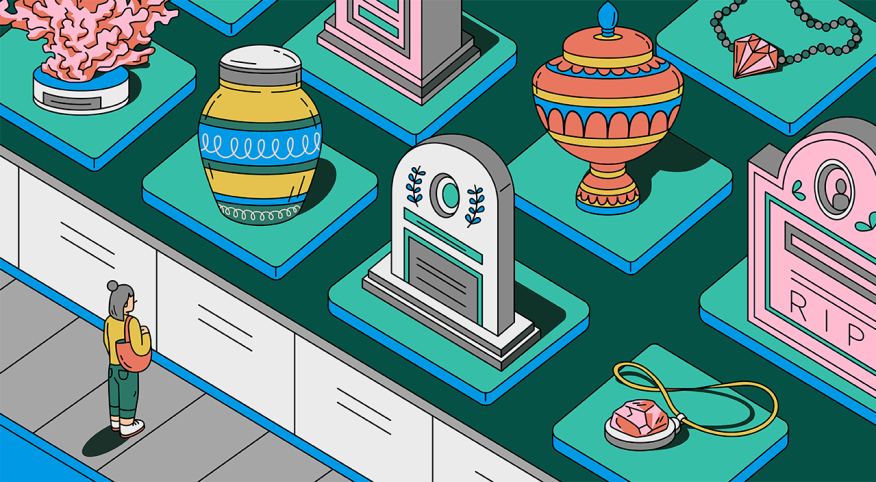Between huge bites of a lox-and-cream-cheese-slathered bagel — essential cuisine served to visitors paying shiva, a Jewish condolence call — my cousin was woeful when he blurted out: “How could we bury Aunt Bronka 100 miles from her brothers’ graves? We should dig up her body and move it to New Jersey.”
Of course, this was not going to happen — though it did make me newly relieved that my mom and dad were resting side by side in immaculately maintained graves, in Babylon, Long Island. She died first, and my dad joined her a few years later, making it easy to visit both at once. Their presence lives inside me 24/7, not just during sporadic pilgrimages to tearfully hug their joint headstone.
What will be my last resting spot? I assumed my eventual afterlife itinerary would include a coffin with a view of my parents’ plot. Yet I find myself among the 63 percent of Americans between 55 and 74 who, according to a 2021 survey, haven’t yet pulled the metaphorical plug and inked solid body-disposal plans.
Sloan Smiloff, a New Jersey-based psychologist, suggests the mass reticence of boomers to dot the i’s, cross the t’s and add a definitive period to the run-on sentence of our existence is partly “a narcissistic effort to be remembered, not be dead.” Guilty as charged. But having created plenty of metaphorical and literal messes during my lifetime, over my dead body will I allow my corpse to create clutter and chaos. With COVID-19 causing death rates to spike nearly 19 percent between 2019 and 2020 — the largest upsurge in a century! — cemeteries are increasingly crunched for space. And as numerous studies indicate, metal casket-in-ground burials wreak havoc on the environment.
I can eliminate one option from the choice I need to make: being frozen in hopes of one day being revived. I hate the cold! Besides, the cost of a full-body cryopreservation is $200,000! So, how do I figure out a plan that makes spiritual, moral and ethical sense to me and causes as little trauma as possible to loved ones?
Six feet under
The traditional embalming-and-casket burial is rapidly losing ground, with the National Funeral Directors Association (NFDA) projecting by 2035 that nearly 80 percent of Americans will opt for cremation over burial. How to nail down an eternal resting spot is a popular topic among my friend group in our 60s and beyond.
Debbie says she will never opt for her corpse to be cremated. When the time is nigh, she plans on joining three generations of family members buried at Mount Hebron Cemetery in Flushing, New York. “My grandparents and parents died before my daughter was born, so visiting the cemetery with my daughter brought a feeling of connection between generations,” she explains. “Cemeteries can be more than a place for dead bodies.”
A growing number of Americans are drawn to a “green burial,” where the body is neither prepared with embalming fluids nor cremated and interred in a biodegradable container. My friend Erika’s remains will rest in Fernwood, a “mixed use” cemetery in San Francisco where her husband and two grandparents “were buried conventionally.” Her mother’s body is also at Fernwood — wrapped in a shroud. “I love the idea of my body dissolving naturally into the soil,” Erika says.
Cremation?
As a child of Holocaust survivors, the idea of voluntarily offering up my body to a crematorium feels creepy. Yet I am tempted, especially as leaders of many faiths including all but the most Orthodox branch of Judaism, are reinterpreting scripture to informally sanction this popular end-of-life choice.
Though the body is eviscerated, cremation offers many options for self-expression. Darren Crouch, CEO of Passages International, which specializes in biodegradable and eco-friendly funeral products, explained to me recently: “People want their remains scattered somewhere meaningful to them, as well as to provide the living with a sense of closure, celebration and honor.” His clients have chosen to be scattered in locales ranging from Disney World to Hawaii. Crouch recalls one family purchasing dozens of tiny “keepsake”-size urns — allowing for the simultaneous emptying of 40 of them off the side of a whale-watching boat.
Cremated remains, called “cremains,” can actually be transformed into jewelry, paperweights or memorial glass art by adding ashes to glass that is liquefied, by heating it to over 2000 degrees. My Facebook friend Betty is planning to have her ashes become part of an artificial ocean reef. According to EternalReefs.com, this process involves the cremains being incorporated into an “environmentally safe cement mixture designed to create artificial reef formations.”
Betty’s reasoning: “I like the idea of helping to repopulate marine life and grow new coral reefs.” While more environmentally friendly than traditional burial, cremation requires the burning of fossil fuels. Even after his 2021 death, Desmond Tutu led by example.
The revered Anglican bishop chose “aquamation” — water cremation, which uses 85 percent less energy to break down the body than fire. Like standard cremation, families receive ashes of their loved ones.
Return to the land
Those who are attracted to the idea, like Erika, of “dissolving naturally into soil,” might want to contact Recompose, the country’s first funeral home to offer human composting. Also called natural organic reduction, NOR is legal in six states — including mine. The process involves placing the body — along with organic materials such as wood chips, straw and alfalfa to speed the decomposition process — inside a cylindrical steel container. Over approximately a 30-day period, during which oxygen and heat are applied to the container, the deceased is gently transformed into nutrient-rich soil that can be used for anything from mixing into a flower bed, planting a tree or donating to a conservation organization.
I have “organ donor” checked on my driver’s license. My still-evolving plan is living long enough for aquamation to be legalized in New York. This would be followed by an oceanside memorial service, and having a mix of my ashes and those of my dead cats, Thor and Axel, sprinkled at one of my two “soul spots” — the crashing waves of Montauk or Big Sur at sunset.
While still earthbound, I’m not losing sleep over my last known address. I know my soul will be winging its way to a reunion with my parents and other departed loved ones.
Has anyone had to shop around before paying for a funeral? Let us know how it went in the comments below.

Jared Oriel
Follow Article Topics: Money





